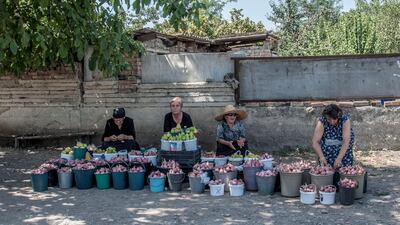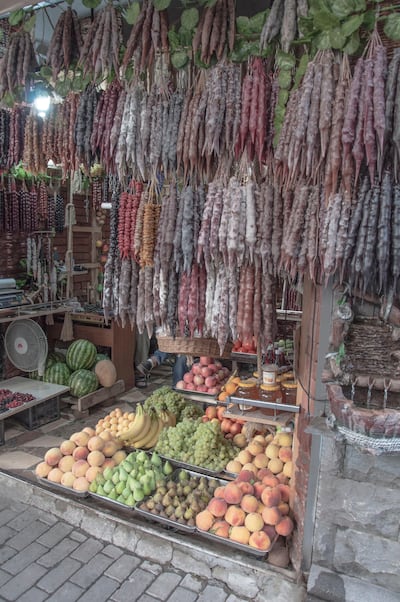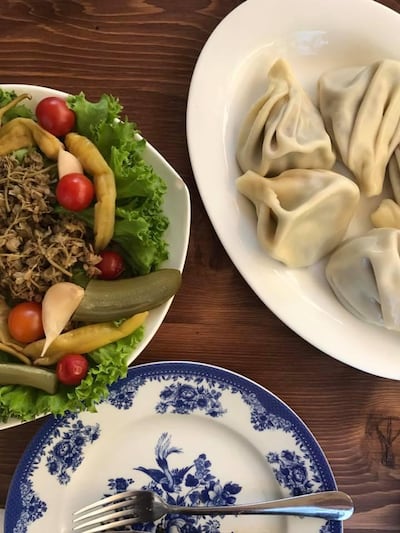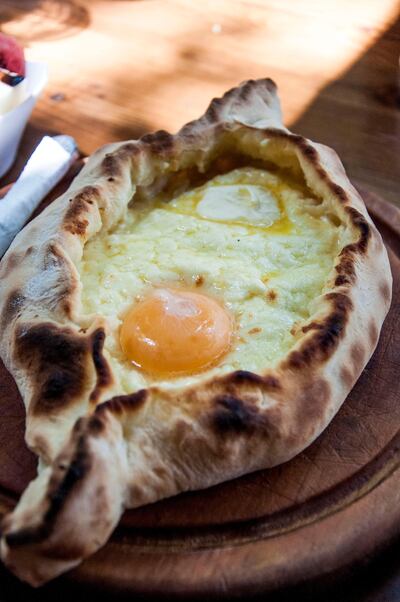With a combination of rugged mountains and majestic lakes, vast stretches of grapevine-studded flatland, sweeping hills and a culturally rich capital, there is something altogether enchanting about the country of Georgia.
As well as bearing the hallmarks of a tumultuous history, Georgian cooking also reflects the country's location. Frequently described as the point at which Europe and Asia meet, Georgia is flanked by the Black Sea, and borders Turkey, Russia, Azerbaijan and Armenia. The climate is, for the most part, temperate and Mediterranean, resulting in exceptionally fresh produce. These elements combine to produce a cuisine that is as wonderfully unique as the country's landscape.
Yet despite all this, it is only relatively recently that Georgia has come to be regarded as a tourist destination; suddenly, it seems like the country is on every traveller's radar. Given that Tbilisi (the capital) is less than a four-hour flight from the UAE (and a direct flight at that), if this destination is not already on your holiday bucket list, then it should be.
But before you pack your bags, read our primer on Georgian food, because this is a country that takes its cooking – and eating – very seriously indeed, and there are plenty of tasty treats to be sampled.
Tkemali
To give you some idea of the zeal for, and indeed tastiness of, this brightly coloured, tart-sweet plum sauce, it has inspired a famous saying that translates as "with a Georgian sauce you can swallow nails".
Tkemali tends to be made twice a year in great batches. Unripe green tkemali plums are used in the spring, and their red, sun-ripened sisters towards the end of the summer. With both preparations, the plums are cooked until soft, before being passed through a sieve to remove the stones and skin. The flesh is then gently simmered with garlic, fresh herbs and Georgian spices.
Pay Georgia even the most fleeting of visits and it's more than likely that you'll taste tkemali. It is added to stews and slow-cooked dishes for depth of flavour, drizzled over salads, served as a dip with bread and potatoes and, most commonly of all, offered as an accompaniment to mtsvadi (seasoned skewers of meat roasted over an open flame).
_____________________
Read more:
Find out where to go in Dubai to get a proper taste of Uzbek cuisine
New restaurants, deals and menus: your guide to summer dining in the UAE
_____________________
Churchkhela
With their waxy, candle-like appearance and array of colours – yellow, black, deep purple, orange and rose – the bunches of churchkhela that hang from market stalls or in storefront windows throughout Georgia could easily be dismissed as merely decorative. They are worth investigating further though, because they're actually a sweet, addictive tasting candy nicknamed the "Georgian Snickers".
Churchkhela are made by first threading shelled nuts (most often walnut halves) on to lengths of string with a needle. The nuts are then dipped, several times over, into concentrated grape juice that has been thickened with flour. Each layer is left to dry in the sun before the next is added, resulting in the nuts being surrounded by a chewy, confectionery-like shell.
Thanks to the combination of protein from the nuts and sugar courtesy of the grape juice, churchkhela are said to have sustained Georgian soldiers when going into battle. These days, however, they are enjoyed as a snack, added to cheeseboards and eaten with dessert, particularly at Christmas and New Year.
Khinkali
Vying with khachapuri (more on them later), for the title of Georgia's national dish, khinkali are this country's contribution to the world of dumplings – and what a contribution they are. Khinkali are large, as dumplings go, and distinctive-looking thanks to their many pleats and a cute little top knot, called the kudi (hat) or kuchi (belly button).
Khinkali are usually filled with minced beef or lamb, spices and herbs (although cheese and mushroom versions are popular too) and are either steamed or boiled. Order khinkali at a restaurant and a large plate filled with several black pepper-flecked dumplings will arrive, along with a sense of urgency, for they are best eaten hot.
It's at this point that the uninitiated risk embarrassment, because there is a set etiquette for eating khinkali. Make a claw-shape with your fingers and pick the dumpling up by the tail, turning it upside down as you bring it to your mouth. Take a small bite from the side and quickly slurp up the delicious broth within (it will spill out and be lost if you don't act fast).
Eat the rest of the dumpling, but never the top knot. Instead, leave it on the plate so that your host can tally up how many you've consumed.
Khachapuri
An article about Georgian food that didn’t feature khachapuri would be remiss, unforgivable even. After all, for many Georgians, a meal without some variety of this cheese bread is considered incomplete.
Many types of khachapuri are sold across the country, with recipes, presentation and ingredients varying along the way. Megruli khachapuri tend to be circular, with the cheese sprinkled on top, pizza-style, while imeruli khachapuri (again circular) feature the cheese mix suspended in the centre of the bread.
It is acharuli khachapuri that tends to steal the most hearts, though – and it's easy to see why. The raw bread dough is formed into a boat or canoe shape, which acts as a shell for the salty, local sulgoni cheese held within. The bread is then cooked in a wood-fired oven (so that the base develops a lovely char) and is whipped away from the heat and topped with a raw egg yolk just before it's ready, before being cooked for just a few seconds more. A last-minute slick of butter provides the final adornment ahead of the delicious dish being served.
It's then up to the lucky recipient to swirl the butter and bright egg yolk into the piping hot cheese. Working from the outside in, tear off thick pieces of the golden crust, dunk them into the bubbling, molten mass, and stop to enjoy your moments of bliss.
At present, Little Georgia is, to our knowledge, the only Georgian restaurant in the UAE (we predict more to come). Luckily, it is a gem, although it is tiny, with only three tables and a minute kitchen where khinkali, khachapuri and more Georgian delights are prepared to order. The restaurant is located in Cluster I at Dubai's Jumeirah Lakes Towers, but it offers delivery throughout Dubai.




